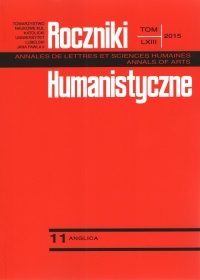The Hasidic context of nature and music in Denise Levertov’s Relearning the Alphabet
Abstrakt
Hasydzki kontekst natury i muzyki w Relearning the Alphabet Denise Levertov
W artykule dokonano interpretacji tomu poezji Denise Levertov, Relearning the Alphabet (1970), posiadającego liczne odniesienia do tradycji chasydzkiej, z której wywodzi się poetka. Najistotniejszymi elementami, do których nawiązuje Levertov, są natura i muzyka, odnoszące się do tradycji jej przodków. Istotną rolę odgrywa również eklektyzm, dzięki któremu Levertov rozwija swoją duchowość. W artykule skoncentrowano się na symbolach, opowieściach oraz na mistyce chasydzkiej, w której zakorzeniony jest szacunek dla środowiska oraz uwielbienie muzyki. Główną tezą artykułu jest twierdzenie, że źródłami wrażliwości na piękno natury oraz muzykalności wierszy Levertov są chasydzkie korzenie poetki.
Bibliografia
Beck, Lorraine Joyce.“Denise Levertov’s Poetics and Oblique Prayers”. Denise Levertov Selected Criticism. Ed. Albert Gelpi, 268–287. The University of Michigan Press, 1993.
Buber, Martin.Tales of the Hasidim. New York: Schocken Books, 1991.
Cone, Temple. “Hasidism in Poetry”. Poetry and Dialogism. Hearing Over. Ed. Mara Scanlon, Had Engbers, 123–139. Palgrave: Macmillan, 2014.
Felstiner, John. “The Hasid and the Kabbalist”. Robert Duncan and Denise Levertov The Poetry of Politics, The Politics of Poetry. Ed. Albert Gelpi, and Robert Bertholf, 81–92. Stanford University Press, 2006.
Greene, Dana. “Denise Levertov: Poet and Pilgrim”. Logos, 13:2, Spring 2010: 94–105.
Hallisey, Joan. “Denise Levertov sings “The Unheard Music of that Vanished Lyre”. Renascence, 50 (1997-1998): 1–2.
Hallisey, Joan. “Denise Levertov’s “Illustrious Ancestors”: The Hassidic Influence”. Denise Levertov Selected Criticism. Ed. Albert Gelpi, 260–267. The University of Michigan Press, 1993.
Levertov, Denise. Relearning the Alphabet. New York: A New Directions Book, 1970.
Levertov, Denise. The Poet in the World. New York: A New Directions Book, 1973.
Levertov, Denise. Light up the Cave. New York: A New Directions Book, 1981.
Lurker, Manfred. Przesłanie symboli w mitach, kulturach i religiach. Kraków: Wydawnictwo Znak, 1994.
Minkin, Jacob. “Jewish Mysticism”. Web. 21.01.2014 <http://www.jstor.org/stable/1198293>
Rebbe Nachman of Breslov. The Empty Chair: Finding Hope and Joy. Woodstock: Jewish Lights Publishing, 2011.
Scholem, Gershom. Major Trends in Jewish Mysticism. New York: Schocken Books, 1954.
The Norton Anthology of Poetry, Fourth Edition. New York: W.W. Norton and Company, Inc. 1996.
Tresidder, Jack. Słownik symboli: ilustrowany przewodnik po tradycyjnych wyrażeniach obrazowych, znakach ikonicznych i emblematach. Warszawa: Wydawnictwo RM, 2005.
Wagner, Linda Walshimer. Denise Levertov. New York: Twyne Publishers, Inc., 1967.
Copyright (c) 2015 Roczniki Humanistyczne

Utwór dostępny jest na licencji Creative Commons Uznanie autorstwa – Użycie niekomercyjne – Bez utworów zależnych 4.0 Międzynarodowe.





